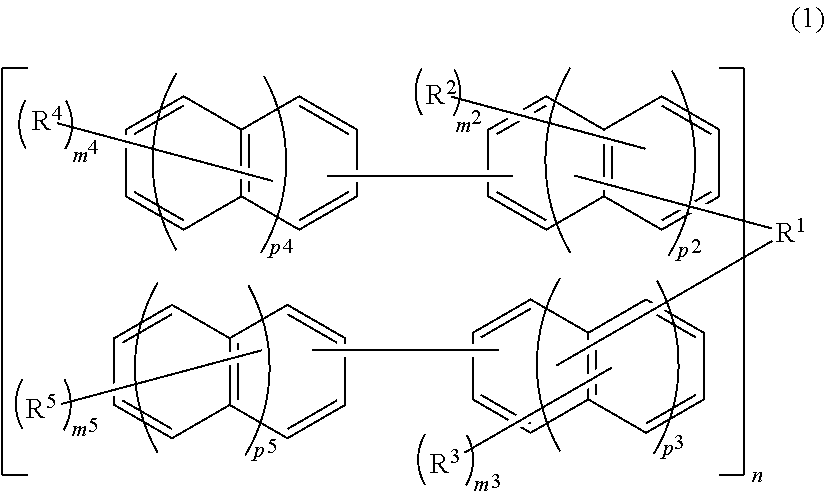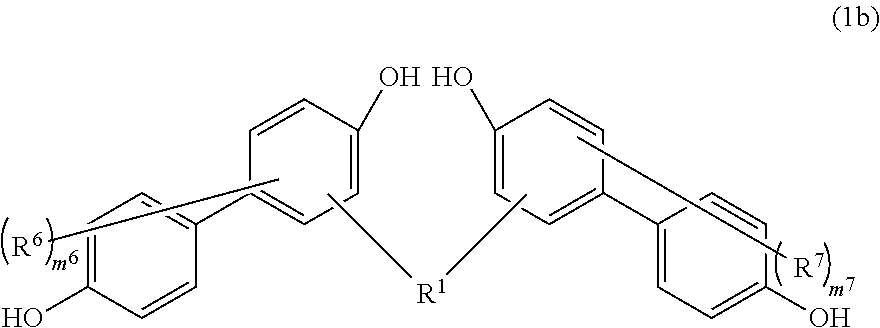Compound, resin, material for forming underlayer film for lithography, underlayer film for lithography, pattern forming method, and method for purifying the compound or resin
a compound or resin technology, applied in the field of compound or resin, can solve the problems of difficult to achieve resist pattern having a film thickness sufficient for processing a substrate, and the intrinsic limitation of light source wavelength, and achieve excellent heat resistance and etching resistance.
- Summary
- Abstract
- Description
- Claims
- Application Information
AI Technical Summary
Benefits of technology
Problems solved by technology
Method used
Image
Examples
example 1
Synthesis of BiF-1
[0206]A container having an inner volume of 200 mL, equipped with a stirrer, a condenser and a burette, was prepared. To this container were charged 30 g (161 mmol) of 4,4-biphenol (reagent produced by Tokyo Chemical Industry Co., Ltd.), 15 g (82 mmol) of 4-biphenylaldehyde (produced by Mitsubishi Gas Chemical Company, Inc.) and 100 mL of butyl acetate, and 3.9 g (21 mmol) of p-toluenesulfonic acid (reagent produced by Kanto Chemical Co., Inc.) was added thereto to prepare a reaction liquid. The reaction liquid was stirred at 90° C. for 3 hours to perform a reaction. Then, the reaction liquid was concentrated, 50 g of heptane was added thereto to precipitate a reaction product, and the resultant was cooled to room temperature followed by filtration for separation. A solid obtained by filtration was dried, and thereafter separated and purified by column chromatography to thereby provide 5.8 g of an objective compound (BiF-1) represented by the following formula.
[020...
example 2
Synthesis of BiF-2
[0214]A container having an inner volume of 300 mL, equipped with a stirrer, a condenser and a burette, was prepared. To this container were charged 60 g (178 mmol) of OPP-BP (produced by Honshu Chemical Industry Co., Ltd.), 16 g (89 mmol) of 4-biphenylaldehyde (produced by Mitsubishi Gas Chemical Company, Inc.) and 100 mL of butyl acetate, and 3.9 g (21 mmol) of p-toluenesulfonic acid (reagent produced by Kanto Chemical Co., Inc.) was added thereto to prepare a reaction liquid. The reaction liquid was stirred at 90° C. for 5 hours to perform a reaction. Then, the reaction liquid was concentrated, 100 g of heptane was added thereto to precipitate a reaction product, and the resultant was cooled to room temperature followed by filtration for separation. A solid obtained by filtration was dried, and thereafter separated and purified by column chromatography to thereby provide 7.5 g of an objective compound (BiF-2) represented by the following formula.
[0215]Herein, th...
example 3
[0222]A four-neck flask having a bottom outlet and an inner volume of 1 L, equipped with a Dimroth condenser, a thermometer and a stirring blade was prepared. To this four-neck flask were charged 376 g (0.7 mol) of compound (BiF-1) obtained in Example 1, 210 g (2.8 mol as formaldehyde, produced by Mitsubishi Gas Chemical Company, Inc.) of a 40% by mass aqueous formalin solution and 0.01 mL of 98% by mass sulfuric acid under a nitrogen stream, and the reaction was allowed to run under ordinary pressure for 7 hours with refluxing at 100° C. Thereafter, 180 g of ethylglyme (special grade chemical, produced by Tokyo Chemical Industry Co., Ltd.) as a dilution solvent was added to the reaction liquid and left to stand, and then an aqueous phase being a bottom phase was removed. Furthermore, the resultant was neutralized and washed with water, and the solvent was distilled off under reduced pressure to thereby provide 354 g of resin (BiFP-1) as a light-brown solid.
[0223]The molecular weigh...
PUM
| Property | Measurement | Unit |
|---|---|---|
| temperature | aaaaa | aaaaa |
| temperature | aaaaa | aaaaa |
| temperature | aaaaa | aaaaa |
Abstract
Description
Claims
Application Information
 Login to View More
Login to View More - R&D
- Intellectual Property
- Life Sciences
- Materials
- Tech Scout
- Unparalleled Data Quality
- Higher Quality Content
- 60% Fewer Hallucinations
Browse by: Latest US Patents, China's latest patents, Technical Efficacy Thesaurus, Application Domain, Technology Topic, Popular Technical Reports.
© 2025 PatSnap. All rights reserved.Legal|Privacy policy|Modern Slavery Act Transparency Statement|Sitemap|About US| Contact US: help@patsnap.com



